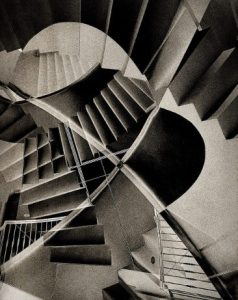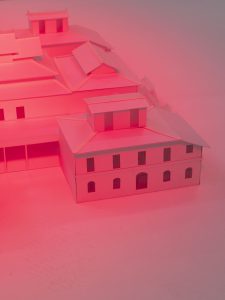Please scroll down for English
דוד ריב 48—60—300 ציורים ועבודות וידאו 2014 – 1994
הענקת פרס רפפורט לאמן ישראלי בכיר לדוד ריב היא מההחלטות המוצלחות שנעשו מאז יסוד הפרס ב 2006 וזאת אף שאינני מהמחשיבים את ריב לאמן מצוין.
האמביוולנטיות ליוותה את הצפייה שלי בתערוכה 48—60—300 ציורים ועבודות וידאו 2014 – 1994 ואת הקריאה בקטלוג. האמנות של ריב שוכנת בלב הזרם המרכזי הישראלי והוא מאומץ לחיק הממסד שוב ושוב – רשימת הפרסים שקיבל כוללת כמעט כל פרס ממלכתי או סמי ממלכתי המוענק בארץ. באוספים ישראלים רכישת עבודה של ריב היא בבחינת צעד הכרחי לבניית התדמית הפתוחה,ליברלית,סבלנית הרצויה.

Facebook Painting, acrylic on canvas
–
100×133 ,2010
הפרויקט הרעיוני אמנותי של ריב נגד הכיבוש הישראלי בשטחים מרשים בהיקפו ותחושת הלהט שמתלווה לו. הוא מגלם את התפיסה האינסטרומנטלית של אמנות, ניסוח פחות מעודן לדיבור הרב על אתיקה שיש בקטלוג.
דורית לויטה הרטן משרטטת היפותזה ובה אפולוגטיקה עתידית של האמנות הישראלית בעוד מאה שנה , “ישראל כפי שהיא היום תחדל להתקיים” כותבת הרטן ” ואם בכל זאת עדיין תתקיים, לא יהיה עוד כל דמיון בינה לבין דמותה החברתית והפוליטית בהווה…. אלא שהאפולוגטיקה העתידית שנחזתה לעיל לא תחול על דוד ריב, המקפיד – הן באמנותו והן בפעולותיו הציבוריות – להציג אמירה החלטית ואמיצה כנגד המצב הפוליטי בישראל“.
המאמר של איתמר לוי המתמקד בסרטי הוידיאו התיעודיים המוצגים בתערוכה מסתיים בקרשנדו שמקריאתו לא ניתן לנחש שנכתב לתערוכה שנערכת במעוז ממסדי “צריך לשאול “האם זו אמנות?”, והתשובה אינה רק: כן, זו אמנות, הרחבה של מושג האמנות, או מחאה נגדו. זו גם מעין טענת נגד שאומרת: איך אפשר ליצור במקום הזה אמנות שאיננה כזאת? איך אפשר ליצור בארץ אמנות “נורמלית”, כאילו אנחנו עוד מקום נורמלי, שאמנים יוצרים בו אמנות? סרטי הווידיאו הם “חזית הסירוב”: הסירוב לשגרה המנרמלת, לאמנות הנורמלית, לתודעה המרגישה בבית בתל אביב, עם אבטיח ביד מול החדשות בטלוויזיה“.
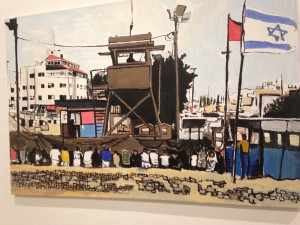
הטענה שהעמדה הפוליטית החד משמעית של ריב ייחודית בשדה הישראלי נשמעת טוב אך ספק גדול אם תעמוד בבחינה מקפת של היצירה הישראלית.התביעה החד משמעית מאמנות להיות פוליטית מסוכנת. היא מסוכנת משום שהיא מניחה שהדובר יודע מה נכון לאמנות והוא גם בעל מונופול על עמדה נכונה. בקטלוג משווים בין ריב לאמנים פוליטיים בינלאומיים בולטים מהאנס האקה הגרמני ועד לאון גלוב האמריקאי. לשני האמנים האלו גוף יצירות שמרגש בהרבה מהעבודות של ריב ובעיקר מושחז יותר .
ריב משתמש באמנות ככלי להעברת המסר שלו בספציפיות ועיקשות, כאשר חישני הרגישות מופנים למי שהוא רואה בהם את הצד החלש. אין כאן טענה לריב על כך שאינו מייצג תמונה מורכבת של המציאות (סופו של דבר ריב הוא אמן ולא משרד החוץ האמריקאי). בכל זאת בצפייה בתערוכה, בעת הזו של מלחמה, בולט שחמש עשרה שנות ירי על הדרום שגבו מחיר כבד מאזרחים ישראלים לא תורגמו לאמפטיה חזותית וכך גם שלוש שנות הטבח באזרחים בסוריה.
כמו הרוב המכריע של האמנים הישראלים גם הפרשנות של ריב לפוליטי היא כמעט לחלוטין על טהרת הסכסוך הישראלי פלסטיני עם נגיעות תקינות פוליטית בעובדים זרים. ריב, מביע בשפת האמנות את עמדת השמאל הישראלי המסורתי שתמציתה “די לכיבוש” איתה אני מזדהה בכל ליבי אך מצרה על כך שהאשליה שהתגשמותה תביא שלום התנפצה .בהנכחה חזותית של עובדי קבלן, עניים או נשים מוכות ,ריב, ואמנים אחרים פשוט עוד לא התפנו לטפל.

Bougainvillea, acrylic on canvas
–
100×150 ,2009
התערוכה אינה רטרוספקטיבה אלא למעשה תערוכת היחיד החד עשורית שלו במוזיאון תל-אביב: ב 1983, ב 1994 וכעת . בעשור האחד בו לא הציג תערוכת יחיד הוא הוצג בהרחבה במוזיאון ישראל בתערוכה זוגית עם מיקי קרצמן במקביל לעשרות תערוכות נוספות בארץ ובעולם.
ריב מצייר עוולות ועיוותים בעבודות כמו ציור פייסבוק, בו עומדים ארבעה חיילים מעל בחורים עצורים שעיניהם מכוסות פלנליות, או מחסום א – רם עם תור האנשים המחכים מתחת למגדל לארץ מובטחת שלא יבואו בה. הוא מצייר רגעים דרמטיים לצד התנהלות שגרתית כביכול וגורם לצופים המכירים את נרטיב הסכסוך לחוש את הלבה המאיימת להתפרץ. כמה מהציורים הם לפי קונטקים לפי צילומים של מיקי קרצמן ,שיתוף פעולה זה הוצג ב קונטרול : מיקי קרצמן ודוד ריב – צילום וציור שנערכה במוזיאון ישראל ב 2003.
הציור של ריב הוא בן זמנו – התקופה של אחרי החזרה לציור שאפיינה את מחצית שנות ה 70 . וההשפעות כוללות את גרהרד ריכטר (עם המסעות לתוך המופשט ) ולוק טימנס ,גני הולצר וקית הרינג, און קווארה ורבים נוספים. הצמחים בעציצים מתכתבים עם עסאם אבו שקרה. בולט גם הקשר הרעיוני למשה גרשוני כמו בסידרת הכלניות שבשמן מהדהדות הרקפות של גרשוני משנות ה 80 או הטיפול בדיוקנאות מנהיגים.
היבט נוסף שעולה מהתערוכה הוא עד כמה צמחה באמנות הישראלית “אסכולת ריב” מדוראר בכרי ועד טליה ישראלי.
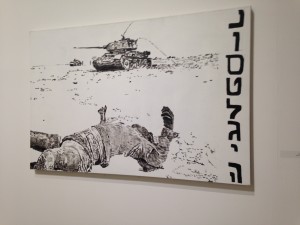
Nostalgia, acrylic on canvas
–
100×150 ,2012
עבודות הטקסט, ציורים עם טקסט משולב ודיוקנאות מנהיגים מתקופת מלחמת יום כיפור, התקופה טראומטית והמעצבת של ריב מעמתים עם יגון ומרירות וזעם וחלקם כמו נוסטלגיה הן מהעבודות החזקות בתערוכה.
סרטי הוידיאו מוקרנים בחדרים שנבנו בלב האולם התחתון. ריב מתעד ההפגנות הנערכות מידי יום שישי בבילעין, בנעלין ובנבי סלאח בשטחים. היותן חוזרות ונשנות לא מגינה על משתתפיהן ופלשתינים כבר נהרגו במהלכן. המקרים שריב תיעד מוקרנים בתערוכה. הצפייה נעה בין השתוממות על האופן בו כל צד ממלא מה שנראה כתפקיד שבמאי שמבקש להדגיש אבסורד נתן לו ,לבין התקוממות על והאיוולת וחוסר התוחלת. חולפת גם מחשבה על כך שבחלקים מאזורינו כבר לא יתכנו הפגנות שנשים גלויות פנים יובילו בסיסמאות קצובות.
החומרים האלו , ודומים להם מוכרים למי שמעורב פוליטית, ולו במעט,– לריב יש אתר ובו סרטי. וסרטים דומים להם מועברים ברשתות חברתיות ומיילים לעיתים תכופות. השינוי שחווים הוא באופן הצפייה: לא מול המחשב אלא על מסך גדול בחדרון שחור. זו פעולה אמנותית מובהקת של עיסוק באופן ייצוג .
עבודות בהן הכיתוב אריק אוכל ילדים שהתייחסו לרה”מ שרון הוסרו מתערוכה במוזיאון תל-אביב ב 2002 וכעת מוצגות, אולי כסוג של תיקון, אבל בוודאי אינם פאר עבודות של ריב .
למרות שהם מוקדמים למסגרת זמן התערוכה, חבל שהדגלונים שעשה ריב יחד עם גבי קלזמר בתערוכתם המשותפת ב 1983 לא שוחזרו. הם נעשו פסים צבעונים של כחול לבן ירוק שחור ואדום ותלו כמו דגלי קישוט במסיבת יום הולדת. הפשטות חשפה את האיוולת בניסיון שהופעל בשטחים הכבושים לצנזר שימוש של אמנים בצבעי דגל פלשתין; הניסיון להסירם מתערוכה בביתן הלנה רובינשטיין ביטאה חשש מכוחה של האמנות .
התערוכה הנוכחית מצביעה על כך שמשקלה של האמנות בשיח הציבורי פחת ( אם לא התפוגג). ואלו אינן חדשות טובות .
מוזיאון תל-אביב לאמנות
אוצרת : אלן גינתון .
הרשמה לניוזלטר הפירסומי השבועי של “החלון” בנושאי אמנות, אירועים ותערוכות חדשות – www.smadarsheffi.com/?p=925
(הרישום נפרד מהרישום לבלוג )
פרטים על קבוצת הסיורים בעברית ל 2014- 2015 ראו בעמודת סיורים והרצאות
David Reeb: 300 60 48
Awarding David Reeb the Rappaport Prize for an Established Israeli Artist, 2013, is one of the best decisions made since the Prize was established in 2006, despite the fact that I am not among those who consider Reeb an outstanding artist.

I remained ambivalent throughout the exhibition and reading of the catalog. Reeb’s art is in the heart of the Israeli mainstream, with his list of prizes and awards comprising nearly every governmental or semi-governmental prize awarded in Israel. Acquisition of a Reeb is almost a “must” for any Israeli collection cultivating an image of liberalism and tolerance. As an art project ideologically opposed to the Israeli occupation of the West Bank, it is impressive in its scope and lasting enthusiasm. It embodies an instrumental perception of art, a less refined definition than the catalog’s multiple mentions of Reeb as an ethical artist.
Doreet LeVitte Harten suggests that there will be future apologetics by Israeli art a century hence: “…Israel as such no longer exists, or, if still alive and kicking, it will certainly have mutated beyond recognition, bearing very little resemblance to its present political and social configuration…The future apologetics I am anticipating here will not refer to David Reeb, who has integrated, in his art as well as his public actions, a strong statement against the political situation in Israel.”
Itamar Levy’s article focusing on Reeb’s documentary video films screened in the exhibition, ends in a crescendo: “Once again we have to ask: Is this art? and the answer is: Yes, this is art, an extension of the notion of art or a protest against it.Concurrently, it is also a counter-argument inquiring: How can one create anyother kind of art here in this place? How can “normal” art be created in this country, as if we were just another normal place where artists make art? The videos are the “refusal front”: the refusal of a normalizing routine, of normalart, of a consciousness that feels at home in Tel Aviv, with watermelon in hand watching the news on television.”
The argument is repeated, that Reeb’s clear and persistent political stance is almost singular on the Israeli art scene, a claim I doubt will withstand a comprehensive survey.
It is dangerous to demand that art be political because such a position assumes that the speaker knows what is correct art and has a monopoly on the truth.The catalog essays contain many comparisons between Reeb and outstanding international political artists such as Hans Hacke (Germany) to Leon Golub (USA). Each of these artists has a body of work much more exciting and caustic than Reeb’s oeuvre.
Reeb uses art as a tool to convey his message; his sensors are consciously internalized, extremely sensitive to those he considers the underdog. This is not a criticism that Reeb fails to depict reality in all its complexity; after all, Reeb is an artist and not the US Department of State. However, walking through the exhibition, during this time of war, it is noticeable that 15 years of rocket attacks on Israel’s south have not been translated into any visual empathy, nor have the past three years of the massacre of Syrian civilians received any representation.
Like the vast majority of Israeli artists, Reeb’s interpretation of politics is narrowly focused on the Israeli-Palestinian conflict, with some politically-correct touches on the situation of foreign workers. Reeb makes direct use of the language of art to express the traditional position of the Israeli Left, best summed up as “End the Occupation,” with which I identify wholeheartedly, although the illusion that ending the Occupation will bring peace has been shattered (it seems that political artists have not yet found the time to address contract workers, poverty and battered women).
The present exhibition is not a Reeb retrospective. It represents his work since 1994, when he had a one-person exhibition at the Tel Aviv Museum of Art, as he did in 1983 (with Gabi Klasmer). In 2003, he participated in a large two-person exhibition at the Israel Museum, Jerusalem(Control: Miki Kratsman and David Reeb, Photographs and Paintings, 2003) and dozens of exhibitions in Israel and abroad.

Facebook Painting, acrylic on canvas
–
100×133 ,2010
Reeb paints injustices in works such as Facebook Painting,in which four soldiers stand over blindfolded detainees, or A-Ram, a checkpoint with a long line of people waiting under a watchtower for the Promised Land they cannot enter. He paints dramatic moments along with seemingly routine scenes which cause the sensation that the situation is about to burst into flames. Some of his paintings are based on Miki Kratsman’s contact sheets, their collaborative effort exhibited in the aforementioned Control.
Reeb is an artist of his time, the period following “back to painting” characterizing the late 1970s. Noted influences on his work are Gerhard Richter (including forays into abstraction), Luc Tuymans, Jenny Holzer, Keith Haring, On Kawara and many others. Reeb’s houseplants correspond with Assam Abu Shakra’s sabras, and the exhibition brings out the association of his works to Moshe Gershuni’s oeuvre. Reeb’s Anemones resonate with Gershuni’s Cyclamen, as does his handling of political and military leaders.
Another visible aspect is the extent to which the “Reeb School” has grown in Israeli art, from Durar Bacri through Talia Israeli.
Reeb’s works with text, paintings with integrated text, and portraits of leaders from the 1973 War (a traumatic, formative period for him) juxtapose grief, bitterness and rage; some of these works, such as Nostalgia, are among the strongest pieces in the exhibition.
The video films show Reeb’s documentation of the routine Friday demonstrations in the West Bank villages of Bil’in, Na’alin and Nabi Saleh. Although they are routine, that does not protect Palestinian demonstrators, and some were killed during theprotests. The cases Reeb documented are screened as part of the exhibition. Viewing the films createdwonder at the way each side seems to fulfill a role assigned by a director with a taste for the absurd, and between a strong sense of the uselessness of this protest. The thought also crossed my mind that in this region it will soon be impossible for unveiled women to lead demonstrations.
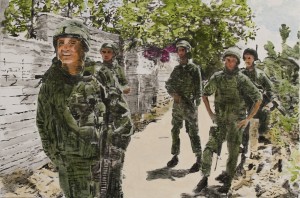
Bougainvillea, acrylic on canvas
–
100×150 ,2009
The films are familiar material to people who are even slightly involved in politics. They can be seen on Reeb’s website, and similar films are frequently transmitted through the social media and e-mails. The shift is in the viewing: it is not on one’s home computer but on a large screen in a darkened room. This is a clear art action of engagement in the mode of representation.
Paintings containing the text Arik Eats Children, which referred to then Prime Minister Arik Sharon, were removed from the Tel Aviv Museum in 2002, and are now hanging in the current show, perhaps to make up for the past, but they are surely not Reeb’s best.
Although they precede the time frame of this exhibition, it is too bad that the small flags that Reeb made with Klasmer for their joint exhibition in 1983 were not recreated. They made flags striped in blue, white, green, black and red, and hung them like party decorations. The simplicity exposed the ridiculous attempt to censor artists in the West Bank from using the colors of the Palestinian flag; the attempt to take them down from the exhibit in the Helena Rubinstein Pavilion expressed fear of the power of art.
Reeb’s exhibition shows that art has lost some of this power – which is not good news at all.
Tel Aviv Museum of Art
Curator: Ellen Ginton
Translated by: Judith Appleton
Join the mailing list for Window’s weekly informational advertising newsletter on art, special events, and openings: www.smadarsheffi.com/?p=925


